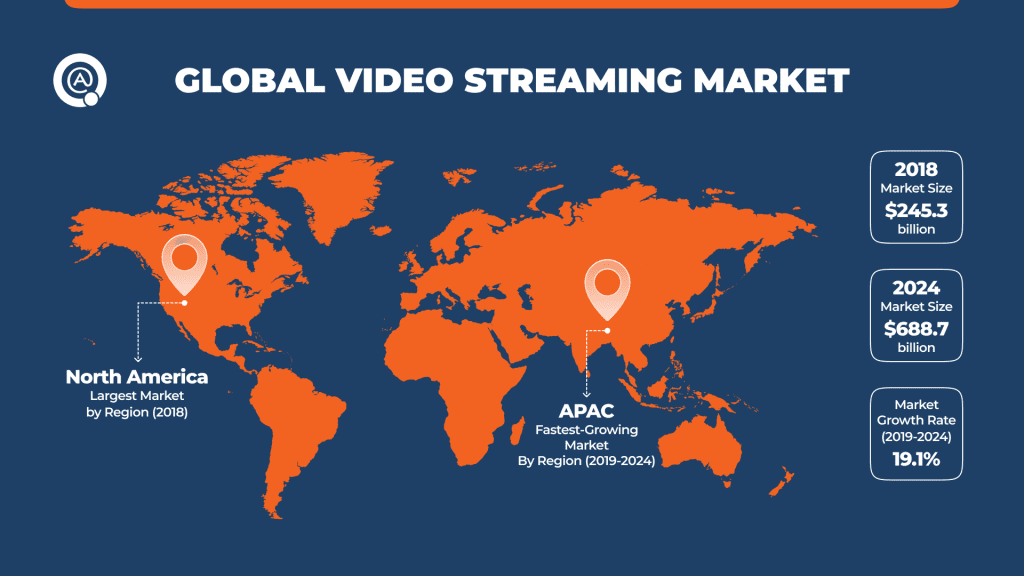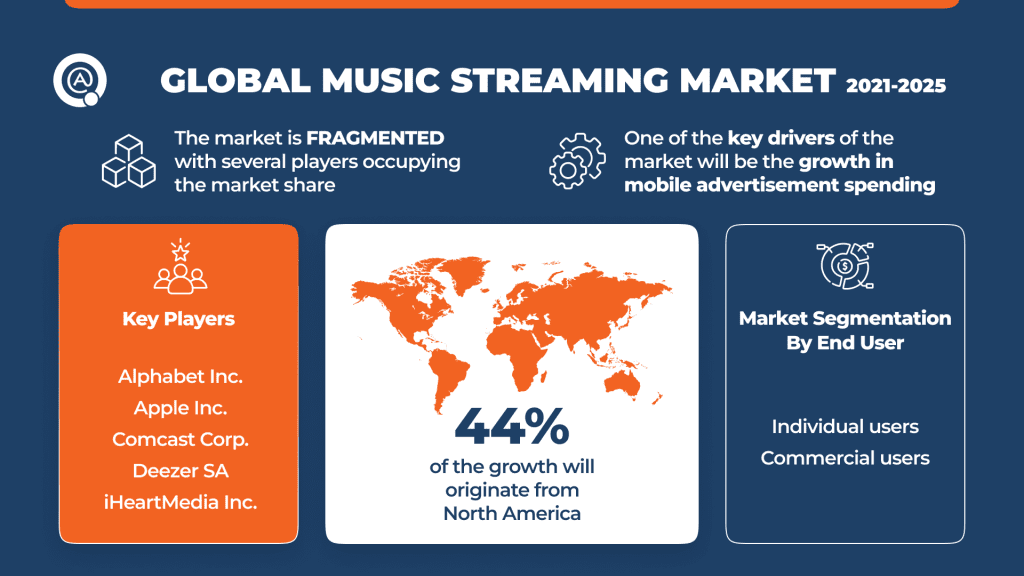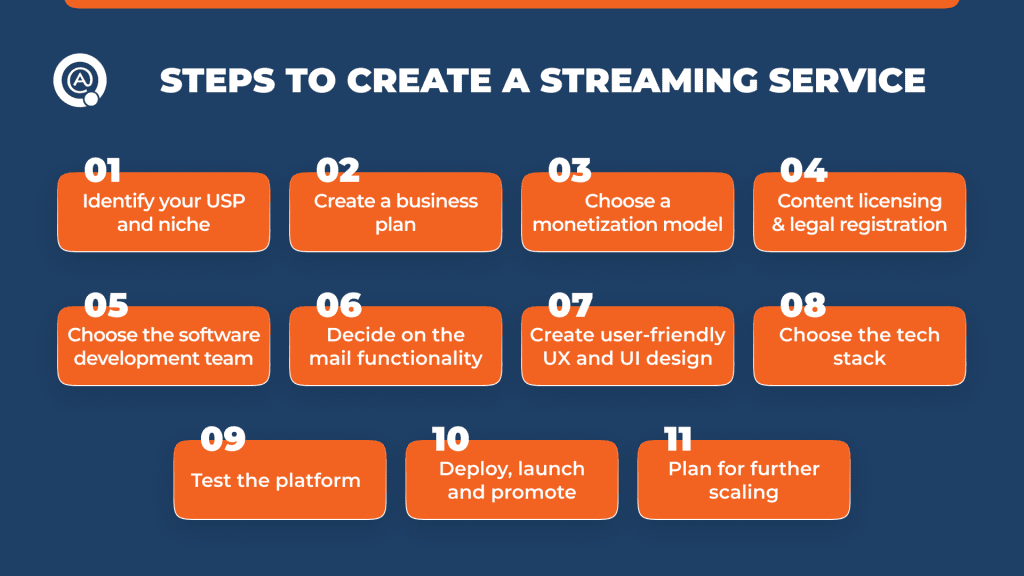Streaming Industry Trends: How Do Business Deal With It?
by Yanina Shabanova | July 27, 2022 9:17 am
The latest digital marketing statistics[1] reflect the growing role of live streaming. For example, video streaming alone accounts for 82% of internet traffic in 2022. It seems that the sphere is revolutionizing both entertainment and business.
The wide availability that streaming technologies provide to users gives creators more options. Blockchain, cryptography, and Web3 promote decentralization. AR/VR, buyable video, and bidding engage consumers in value-added business services.
We decided to take a look at a few trends from global streaming reports and forecasts and discuss how businesses can implement them. So buckle up!
Interface beats content
In the global streaming wars, the strategy often revolves around content, with services competing for franchise rights and intellectual property, likely to drive consumers to their platform.
But consumers have different needs. Statistics show[2] that 70% of customers abandon purchases due to poor user experience. People don’t have time to deal with complex interfaces; they want to be able to access their favorite programs easily. Users don’t want to wander through a confusing maze of buttons, tabs, and folders. That’s why 91% of them just leave, and 13% tell 15 more people about their bad experiences.
Streaming platforms are being created in abundance, and the user experience[3] sets the streaming service apart from the competition in the industry. With the rise of products, customers are no longer tied to one service provider. The options are plentiful; therefore, just a hyper-personalized platform that keeps the viewer at the forefront of the streaming setup makes a striking difference.

Some of the key factors that determine the number of users in 2022 are:
- Intuitive and user-friendly interface
- Seamless navigation
- Custom branding
- Easy content discovery capabilities
- Uncomplicated transaction/payment process
Personalized video content management
A Content Management System (CMS) is a must for every streaming platform. Not only does this help categorize all content and create an organized environment for all the video or audio you offer, but it also makes it easier for users to navigate the system.
As technology improves, content teams have access to more and more customer data. It is highly beneficial as organizations using data-driven marketing are six times more likely[4] to remain profitable than last year.
As a result, the number of content management systems that can process data in real-time is increasing. By using data-driven insights in your content management practices, you can connect with your audience on a more personal level. It ultimately improves the impact of your content.
Some of the most common CMS features you can implement are:
- Personalized library
- Categories and tags
- Voice search
- Ratings and comments
AR, VR and the Metaverse
If you find the metaverse concept vague, you are not alone. This idea is akin to the Internet’s imagination without using a computer. After all, most of us have yet to experiment with sophisticated AR and VR technologies.
Several factors contributed, including the poor quality and processing power of early VR headsets, the overall cost to consumers and content distributors, and bandwidth constraints. Fortunately, these obstacles disappear. We should see a surge in introducing new hardware and 5G connectivity.
But what about the metaverse? In a sense, the metaverse is a “hybrid of everything” at its best — a world in itself that merges the physical and the digital using extended reality (XR) technologies such as AR, VR, and, of course, video galore. But early examples of the metaverse already exist, namely, in games.
Roblox and Fortnite offer user-created immersive worlds, although they are currently displayed on a flat screen. Virtual communities communicate, exchange digital assets, and ultimately create their own reality within these mini-metaverses. In Zuckerberg’s future, users will be able to travel from one of these platforms to another, allowing for a unified metaverse.
AR, VR, and AI are also changing the musical landscape. Music is already being integrated into such experiences through Snapchat Lens, TikTok, and VR headsets. Moreover, users can purchase tickets to see live performances at festivals and their favorite music venues, providing the consumer with a live music festival experience.

Mass immersive broadcasts directly depend on the availability of equipment. However, the value of such livestreams is that users can watch or listen to live shows with greater immersion, communicating with other participants and even performers directly.
User-generated content (UGC)
On the one hand, we have high-performance media, from the Squid Games to the 2022 Winter Olympics in Beijing. On the other hand, we have informal short content like TikTok or Instagram Reels. Both firms compete for users and eat away market share from other platforms.
Retailers rely on both live and concise content to create these virtual shopping environments and technologies such as augmented reality (XR) and machine learning (ML). Instagram and Facebook are now offering Live Shopping, Google is experimenting with Shoploop, and Amazon is offering an omnichannel experience on Amazon Live. Walmart has even teamed up with TikTok to host live shopping streams over the past two holiday seasons.
Most of these e-commerce platforms were created for user-generated content. As such, they would do well to follow TikTok’s lead in prioritizing content personalization. The social media app attracts 1 billion monthly active users[5], and its parent company ByteDance attributes this success to machine learning-based content aggregation.
It is quite challenging to overcome the global giants, but what if you think about creating a niche user platform for users with specific interests? Medicine, cooking, technology reviews — choose the direction that will be interesting for your audience and create your own TikTok.
Conclusion
To find a win-win solution, streaming companies must consider consumer trends and innovative strategies to work. AI, OTT services, esports, and voice streaming are becoming more prevalent. All this is forcing developers of multimedia and entertainment products to use new software production approaches to stay at the top of the competition[6]. And most importantly, do it quickly.

Given the vast number of simultaneous operations, multimedia solutions must be up-to-date and remain good enough to do the job for which they were created. End users have become more selective in their choice of entertainment apps due to the thousands of options on the market.
QA services can significantly support your product and ensure user loyalty. We are always happy to help you with this. Please leave the requests[7] and improve your business together with us.
Learn more from QATestLab
Related Posts:
- digital marketing statistics: https://financesonline.com/streaming-statistics/
- Statistics show: https://uxplanet.org/the-value-of-ux-design-bc22bcd482a4
- user experience: https://qatestlab.com/services/manual-testing/ux-usability-testing/?utm_source=blog&utm_medium=article&utm_campaign=streaming_trends_27072022
- six times more likely: https://www.digitalauthority.me/resources/guide-to-data-driven-marketing/
- 1 billion monthly active users: https://www.cnbc.com/2021/09/27/tiktok-reaches-1-billion-monthly-users.html#:~:text=TikTok%20revealed%20Monday%20it%20has,company%20trails%20Facebook%20in%20users.
- stay at the top of the competition: https://qatestlab.com/request-a-quote//?utm_source=blog&utm_medium=article&utm_campaign=streaming_trends_27072022
- leave the requests: https://qatestlab.com/request-a-quote//?utm_source=blog&utm_medium=article&utm_campaign=streaming_trends_27072022
- Software Quality Trends in 2026: Key Changes Shaping Modern QA: https://blog.qatestlab.com/2025/12/24/software-quality-trends-in-2026-key-changes-shaping-modern-qa/
- SiGMA Central Europe: Quality at the Heart of iGaming Expansion: https://blog.qatestlab.com/2025/11/20/sigma-central-europe-quality-at-the-heart-of-igaming-expansion/
- Automation Testing for Mobile Apps: Why It’s Essential and Our Key Services: https://blog.qatestlab.com/2025/05/13/automation-testing-for-mobile-apps-why-its-essential-and-our-key-services/
Source URL: https://blog.qatestlab.com/2022/07/27/streaming-industry-trends-27072022/

